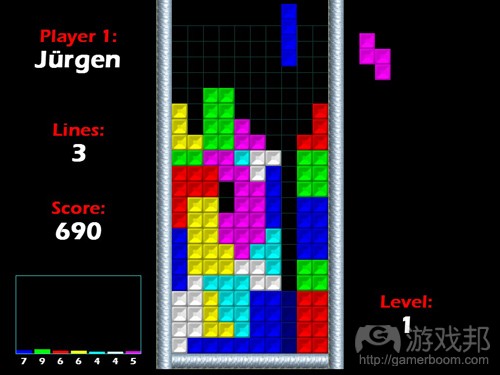论述游戏设计复杂性与成功的关系
作者:Jacek Sliwinski
为何我要费力探讨游戏复杂性与其成功的关系?因为游戏的真实销量数量与其复杂程度似乎存在矛盾。众所周知,《俄罗斯方块》的玩法并不复杂,但它却是史上最成功的佳作之一。但会有人争辩道,《侠盗猎车手》虽然具有更高程度的复杂性,但却同样取得成功。这纯属巧合吗?或者说我们应深入挖掘,找出相关原因?接下来我将探讨这方面内容。
复杂性问题
我并不打算在一开始便介绍复杂性定义。我认为我们(即玩家)均对此有所体会,尤其在玩游戏过程中碰到复杂关卡时。本文提到的复杂性是指玩法方面(根据复杂游戏机制的意义)。当然,我们还可以根据更多标准判断游戏是否复杂。以下为一些分类:
*玩法复杂:特点是具有复杂游戏机制,包括不同输入与输出变量的相互关系。
*叙事复杂:精心制作的决策能够影响游戏的关键元素。
*技能复杂:利用肢体动作操控游戏状态时,应精确灵敏且准确对时。
*认知复杂:包括较高的认知能力,比如时间与空间的心灵转换,计划,及推理。
现在让我们回到本文主题:设想下你十分荣幸获得游戏设计任务。那你将如何合理分配游戏性能设置?游戏应具备多大复杂才能突显出最大乐趣?
但会出现一个恶性思路循环,即休闲玩家要求简单性,硬核玩家要求复杂性。虽然这属于常见情况,但相关解释并非基于理论上,而是之后进行。此外,还未有人真正清楚如何定义休闲玩家或硬核玩家。
复杂性与趣味的关系
之前的博客已探讨过“心流”概念。它(我们称之为趣味的母体)是正确平衡挑战与技能的必要条件。显然,复杂性的提高总是伴随挑战难度的增加出现。当考虑到游戏趣味性方面时,我们认为技能因素会如同游戏功能般不断提升。也就是说,当合理运用游戏复杂性时,它会提高游戏的趣味性,激发玩家的长期游戏动机。但记住不要过早暴露游戏的复杂程度;那样会吓跑用户。
适度采取复杂性
以用户为中心的设计应遵循的一个主要原则是了解自己的用户。这并非意味着简单地将用户定义为休闲类或硬核类。我建议最好基于用户调查开发人物角色。为了定义游戏的正确复杂程度,其中的角色模版应参照:
*基本用户特征,比如年龄(方便找出其认知能力与信息处理能力的局限性),性别(了解相关爱好)。
*首选平台,比如浏览器或是移动平台(游戏邦注:这会影响到每个回合预计的平均体验时长,相关设计内容则能够缓解访问的复杂性)
*人格特征,比如挫折耐力与认知需求(借此判断用户的奖励需求,设计平衡的游戏模式)。
*当然,你可以添加其它要点,这取决于对游戏视角发挥的作用。
记住,上述内容有助于你设计一款理论导向型游戏,但并不能保证你会取得成功。无论你的使用案例有多详尽,你有多熟悉认知演练方法,为了获得合理的游戏复杂性,你最好针对大规模用户进行测试。(本文为游戏邦/gamerboom.com编译,拒绝任何不保留版权的转载,如需转载请联系:游戏邦)
Complexity and Success in Games
by Jacek Sliwinski
The following blog was, unless otherwise noted, independently written by a member of Gamasutra’s game development community. The thoughts and opinions expressed here are not necessarily those of Gamasutra or its parent company.
Why should I bother trying to establish a relation between the complexity of a game and its success? Real data on sales and perceived complexity suggests seemingly conflicting evidence. We all know Tetris, which doesn’t seem to be complex at all, but is one of the most successful games that ever existed. On the other hand, one could argue that Grand Theft Auto is equally successful1, while being more complex by multiple degrees. Does this mean that any relation between complexity and success is purely coincidental? Or do we have to dig deeper to grasp the coherence? Just follow me on my way of reaching clarification and engage in a discussion at the bottom of this page.
Complex, or not complex: that is the question
I won’t start with an introduction about what complexity is or is not. I think we all (we, who play games) have a feeling for what complexity is, especially when we encounter it in the games we play. In this blog post I am referring to the complexity of gameplay only (in the sense of complex gameplay mechanics). Of course, there are more levels, on which a game can be complex. I propose the following classification:
Gameplay complexity: Characterized by sophisticated gameplay mechanics including interrelations between different in- and output variables (Tower Defense <-> Anno).
Narrative complexity: Elaborated decision trees with impact on key elements of the game (Super Mario <-> Heavy Rain).
Skill complexity: Requires fine dexterity and accurate timing in the execution of physical actions to manipulate game states (Minesweeper <-> Street Fighter).
Cognitive complexity: Includes higher cognitive skills like spatial & temporal mental transformation, planning and reasoning (Tetris <-> FoldIt).
But let’s get back to the topic: Imagine you have the honorable task to design a game. How many features are too little and how many are too many? How complex must your game be to squeeze the most fun out of it?
There is one evil superstition circulating, that casual gamers demand simplicity and core gamers complexity. Although this might be true in many cases, explanations are not theory-driven but occur in hindsight. Furthermore, no one really knows how to define a casual or a core gamer. But before talking about the when and how, let’s talk about the why.
Complexity and fun: a love-hate relationship
The blog post prior to this one2 discusses the concept of Flow3. For Flow (the mother of fun as we could call it) a necessary condition is the right balance between challenge and skills. Obviously, an increased complexity comes often with an increased level of challenge. And when we use fun as “just another word for learning” (like Raph Koster does in his book “A Theory of Fun for Game Design”4), we can assume (and as gamers we really know) that the skill factor is successively improving as a function of playtime. So what does this mean? Complexity increases fun and contributes to long-term motivation when it unfolds at the right time and at the right speed. But beware of exposing too much of it too early: you will make your users run (not in-game but away from it). This is exactly what tutorials and balancing (the guidance of mastery) try to prevent.
Complexity: getting the right dosage
One main principle in user-centered design is KNOW YOUR USERS. This doesn’t mean that we simply label our users as core or casual gamers. A tactic I suggest is to develop research-based personas. To identify the right degree of complexity for your game, your persona template should include:
Basic demographics, such as age (for spotting limitations in cognitive abilities and information processing) and gender (for gender-related preferences).
Preferred platform like browser or mobile (which has an influence on the expected mean playtime per session and the design-relevant ease to access/use for complex features)
Personality attributes like frustration-tolerance and need for cognition (to determine how eager for rewards your users are and how to design the balancing curve).
Of course you can add more points, depending on what makes sense for your game vision.
Notice, that this data can be helpful to build a conclusive theory-driven game design but is no guarantee for success. No matter, how detailed your use cases are and how well you mastered the method of cognitive walkthrough, you still have to do extensive user testing in order to get it right.(source:gamasutra)
上一篇:分析电子游戏行业的发展现状及挑战








































 闽公网安备35020302001549号
闽公网安备35020302001549号